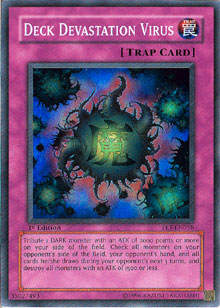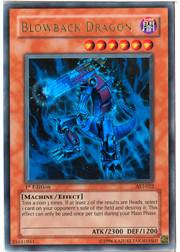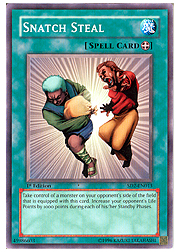 It’s no secret—Deck Devastation Virus is hot. The last format was arguably defined by Spirit Reaper, Dekoichi the Battlechanted Locomotive, and Magical Merchant, which are all monsters that the Virus chews up and spits into the graveyard. The Yu-Gi-Oh! TCG was meant to be about big monsters clashing in battle, and thanks to Deck Devastation Virus, that might be where this format is going.
It’s no secret—Deck Devastation Virus is hot. The last format was arguably defined by Spirit Reaper, Dekoichi the Battlechanted Locomotive, and Magical Merchant, which are all monsters that the Virus chews up and spits into the graveyard. The Yu-Gi-Oh! TCG was meant to be about big monsters clashing in battle, and thanks to Deck Devastation Virus, that might be where this format is going.
Reader Aaron K. sent me a deck focused on the repeated use of the Virus, and I couldn’t resist it. With a bit of tweaking, it’s a great example of how one can use the tricky trap to create a game condition most duelists won’t be able to deal with. Here’s what he had to say about it.
Hello, Jason,
I thought you might be interested in this Advanced format Yu-Gi-Oh! deck. The goal of the deck is to use, re-use, and abuse Deck Devastation Virus. With Mask of Darkness, A Cat of Ill Omen, Book of Moon, and Tsukuyomi, I hope to be able to use it two to three times in a duel. Zombyra makes it easy to activate, and with cards like Reinforcement of the Army and The Warrior Returning Alive, it shouldn’t be too hard to get one into my hand. I've opted for The Fiend Megacyber over cards like Goldd because I like the idea of tributing a special summoned monster for Deck Devastation Virus. And if all else fails, there is good old Strike Ninja to fall back on. Please let me know what you think.
Regards,
Aaron K., Ontario, Canada
Sound cool? It is. Here’s the deck that Aaron sent me, complete with his, um . . . superbly creative deck name.
Deck Devastation Deck
40 cards
Monsters: 19
1 The Fiend Megacyber
3 Zombyra the Dark
1 Giant Orc
2 Mystic Tomato
2 Spirit Reaper
1 A Cat of Ill Omen
1 Mask of Darkness
1 Breaker the Magical Warrior
1 Sangan
1 Strike Ninja
1 Exiled Force
2 Magician of Faith
1 Swarm of Locusts
1 Tsukuyomi
Spells: 14
1 Graceful Charity
2 Reinforcement of the Army
1 Swords of Revealing Light
2 Smashing Ground
1 Premature Burial
2 Nobleman of Crossout
1 The A. Forces
1 The Warrior Returning Alive
1 Heavy Storm
1 Mystical Space Typhoon
1 Book of Moon
Traps: 8
2 Deck Devastation Virus
3 Sakuretsu Armor
1 Call of the Haunted
1 Bottomless Trap Hole
1 Torrential Tribute
Aaron asked what I think, and frankly, I think the deck does a good job of accomplishing what it sets out to do: reliably dig for, use, and reuse Deck Devastation Virus. That said, I’m a little concerned about how well it can capitalize on the conditions it creates, and some of the individual card choices seem counterintuitive. The late game seems especially troubling, not because the deck will topdeck badly (it would likely topdeck on the better side of average), but because its strategic intent can deteriorate pretty quickly. My fixes are aimed at tightening the deck’s focus, making it a little more reliable, and providing it with more support for its theme in the mid- and late game periods of a duel.
First on the chopping block? The Fiend Megacyber. The limiting of D. D. Assailant and the removal of Dark Hole from the Advanced format has made this card more playable than it was in the past, but at the same time, I can’t help but notice an effect that reads “If you’ve totally lost control of the field, summon this dude.” As a monster for which you’d be tributing, it’s shoddy at best, and once a single Deck Devastation Virus gets going, I don’t see it becoming anything but a dead draw. It’s a cool idea to use it here, because as Aaron said, it can special summon The Fiend Megacyber, normal summon another monster, and then use the Megacyber to tribute for Devastation without losing momentum. But for me, the potentially limited utility just doesn’t click.
The same goes for Swarm of Locusts. While this can be an awesome momentum card to punish an opponent who’s already been blasted with Deck Devastation Virus, I don’t think it’s necessary. Once the Virus goes off, the only monsters you’ll see are attack position ones anyway. Though both Swarm of Locusts and Swarm of Scarabs are great ways to shake up conservative duelists, I think those are a dying breed.
The second Magician of Faith is an easy drop. This deck has no particular need to reuse certain spell cards, and losing a pair of slow-tempo monsters to a single Nobleman of Crossout is, in technical terms, “the mad suck.” I’ll be subbing in a replacement for the second Magician that I think will fit the deck better.
There’s no reason for Tsukuyomi to be here. We have unparalleled amounts of field control, and though this deck can play at a slow tempo, it wants to drop a Deck Devastation Virus-bomb and then rocket towards victory. Tsukuyomi is a great card, but it’s not a staple, and it has no business in this deck. Yes, it can generate some card advantage . . . mostly when you already have control of the game. I’d rather use that normal summon to press my advantage and deal damage than draw a card. Very few big monsters can give this deck trouble, so while it’s an answer to the Monarchs, I do believe we have better ones already.
The last monster I want to drop is Strike Ninja. I’ve got different plants for how this deck is going to spend its accumulated body bags, so the Ninja must hop on out of that graveyard and get to walking. Sorry, Ninja.
Moving on to spells, I’m not exactly sure what The A. Forces is doing here. This isn’t a swarm deck, and not two minutes ago, it was counting on a complete lack of field presence to fuel The Fiend Megacyber. Using The A. Forces to boost your Warriors into the range of candidacy for tribute to Deck Devastation Virus would be awfully cute, but this deck can’t do that. Strike Ninja might be able to get to 2100 ATK somewhat reliably, but I dare say it’s not topnotch tribute fodder, and it would probably agree. The A. Forces will be very cool Macro Cosmos tech a couple months down the line, turning D.D. Survivor into a free activation of Deck Devastation Virus, but this just isn’t that deck.
The Warrior Returning Alive? Ironically, it’s not returning. Again, this is going to fit in with my different plans for this deck’s mid- and late game performance. On a personal note, The Warrior Returning Alive is just a useless card in the early game, and that’s always bothered me. If it works for you, by all means use it, but to me it seems like a poor card to see in your opening hand, and those can often equate game losses in aggressive metagames.
The last cut I want to make is one copy of Sakuretsu Armor. I’ll be diversifying the trap base a bit, and I personally feel the trend towards running two Sakuretsu instead of three is a strong one.
We’ve got eight card slots to work with—let’s make some additions!
 The first thing I want to bring to the deck is Blowback Dragon. Blowback is a Dark attribute Machine monster that’s big enough to be tributed for Deck Devastation Virus, and it can lead to some nasty things. Not only can its effect generate a great deal of card advantage, field control, and momentum, but its status as a potential carrier monkey for the Virus allows all sorts of craziness. You can tribute summon it, activate its effect with priority, watch the opponent chain Trap Hole or Bottomless Trap Hole, and then tribute it off for the Virus. Assuming you make your coin flips, you lose a tributed monster, Deck Devastation Virus, and Blowback Dragon in order to take out one of your opponent’s traps, a target for Blowback’s blast, and then whatever Deck Devastation Virus nets you.
The first thing I want to bring to the deck is Blowback Dragon. Blowback is a Dark attribute Machine monster that’s big enough to be tributed for Deck Devastation Virus, and it can lead to some nasty things. Not only can its effect generate a great deal of card advantage, field control, and momentum, but its status as a potential carrier monkey for the Virus allows all sorts of craziness. You can tribute summon it, activate its effect with priority, watch the opponent chain Trap Hole or Bottomless Trap Hole, and then tribute it off for the Virus. Assuming you make your coin flips, you lose a tributed monster, Deck Devastation Virus, and Blowback Dragon in order to take out one of your opponent’s traps, a target for Blowback’s blast, and then whatever Deck Devastation Virus nets you.
Is it likely to be an even exchange of cards, at least at first? Sure, but it also gets your Virus going while simplifying a potentially very large field. Such a move can render a complicated mid-game board utterly empty, and give you an edge to boot, thanks to Virus’s effect. The ability to suddenly simplify the game on such a massive level is something that the departure of Dark Hole has made almost impossible, and any opponent is going to be surprised if you can pull it off. Plus, it’s big and has a gun for a face. That’s the kind of Yu-Gi-Oh! monster that people rap about.
A second Giant Orc will add some more reliability to basically every layer of this deck’s plan. Before you activate Deck Devastation Virus, the Orc is a wall. When you activate the Virus, it’s a tribute. Once you’ve activated it, it’s a massive beatstick that the opponent probably won’t be able to block. Aces all around in my books.
Next up is D. D. Warrior Lady. It doesn’t fit the theme at all, but by Jove, it’s useful. It’s a great early game set, takes care of big monsters later on, and is a nice aggressive attacker in that post-Virus phase where your opponent will really be looking to keep monsters on the field.
Finally for the monster lineup, I’m adding Dekoichi the Battlechanted Locomotive. This is the direction I wanted to diversify the pair of Magician of Faiths into, and I think it’s a solid one, giving the deck an impromptu attacker, another Dark monster in case Strike Ninja wanders into the side deck, and a little bit of acceleration towards its key cards. It also feeds . . .
. . . Pot of Avarice! Hardcore Avarice users might sneer at my insertion of the Pot into a deck that doesn’t run Magical Merchant, but the reality is that this deck tributes monsters (and loses them to battle) a lot more often than average. Pot of Avarice also lets you Recycle the effect monsters—and the big beatsticks—that make this deck work. Sometimes you’ll be stuck in a situation where your Zombyras and Giant Orcs are used up but you haven’t drawn into A Cat of Ill Omen or Deck Devastation Virus yet. This card is the answer to that situation, giving the deck a lot more late-game life. Loading your topdecks with 2100 ATK and 2200 ATK beatsticks isn’t just a cushioned drawback like Avarice users are used to, but it’s frequently an advantage. And of course, drawing two cards is always great. This is not “one random Avarice.” It’s just Pot of Avarice being used a little differently than we’re used to.
The second spell I want to add is Snatch Steal. A battle-oriented deck without Snatch Steal? Sacrilege, I say, and of the highest order. Snatch Steal is especially valuable since this deck doesn’t have its own 2400 ATK beatsticks to match those wielded by the average opponent. If Jinzo’s going to hit the field and negate your primary strategy, you might as well stuff it in a burlap sack and beat your opponent to death with it.
Finally, I’ll stick to my word and complete that trap diversification I’d discussed earlier. With tribute monsters seeing a highly increased level of play the past while, Bottomless Trap Hole and Trap Hole Classic™ get better and better, so I’ll add one of each to the deck. It’s nothing fancy, but it gets the job done.
Here are the fixes I made to the deck.
–1 The Fiend Megacyber
–1 Tsukuyomi
–1 Strike Ninja
–1 Swarm of Locusts
–1 Magician of Faith
–1 The A. Forces
–1 The Warrior Returning Alive
–1 Sakuretsu Armor
+1 Blowback Dragon
+1 Giant Orc
+1 D. D. Warrior Lady
+1 Dekoichi the Battlechanted Locomotive
+1 Snatch Steal
+1 Pot of Avarice
+1 Bottomless Trap Hole
+1 Trap Hole
The final fixed version of Aaron’s masterpiece is as follows!
Deck Devastation Deck: Jason’s Fix
40 cards
Monsters: 18
1 Blowback Dragon
3 Zombyra the Dark
2 Giant Orc
2 Mystic Tomato
2 Spirit Reaper
1 A Cat of Ill Omen
1 Mask of Darkness
1 Breaker the Magical Warrior
1 Sangan
1 Exiled Force
1 Magician of Faith
1 D. D. Warrior Lady
1 Dekoichi the Battlechanted Locomotive
Spells: 14
1 Graceful Charity
2 Reinforcement of the Army
1 Swords of Revealing Light
2 Smashing Ground
1 Premature Burial
2 Nobleman of Crossout
1 Heavy Storm
1 Mystical Space Typhoon
1 Book of Moon
1 Snatch Steal
1 Pot of Avarice
Traps: 9
2 Deck Devastation Virus
2 Sakuretsu Armor
1 Call of the Haunted
2 Bottomless Trap Hole
1 Torrential Tribute
1 Trap Hole
There’s not a whole lot to explain that hasn’t already been said. Judging matchups is pretty easy—the more monsters with 1500 ATK or less a deck plays, the better your chances of winning. Flip-Flop Control, Burn, and, to a lesser degree, Monarch Control, are all favorable decks to compete against, while Chaos and Beatdown will be average or in your advantage.
 Dark World can be a concern if the version used is low on small monsters. Dark World Control will be shredded, but Dark World Beatdown variants could be quite tough. Abuse Snatch Steal whenever possible. Tributing one of the opponent’s copies of Goldd, Wu-Lord of Dark World for a Deck Devastation Virus is magnificently rewarding. Remember that so long as your opponent’s effect discarded Goldd or Sillva, Bottomless Trap Hole can swallow up one of the offending Lords. Also notable is the fact that Deck Devastation Virus destroys cards in hand. It doesn’t discard them, so the Virus can make mincemeat out of Broww, Huntsman of Dark World without incurring any penalty.
Dark World can be a concern if the version used is low on small monsters. Dark World Control will be shredded, but Dark World Beatdown variants could be quite tough. Abuse Snatch Steal whenever possible. Tributing one of the opponent’s copies of Goldd, Wu-Lord of Dark World for a Deck Devastation Virus is magnificently rewarding. Remember that so long as your opponent’s effect discarded Goldd or Sillva, Bottomless Trap Hole can swallow up one of the offending Lords. Also notable is the fact that Deck Devastation Virus destroys cards in hand. It doesn’t discard them, so the Virus can make mincemeat out of Broww, Huntsman of Dark World without incurring any penalty.
You’ll want to play the deck with two goals in mind. The first is to activate the Virus as quickly as possible. You don’t need to worry about trying to gain the maximum card advantage from its use, although if given the chance, try and tribute a monster that is about to be hit by something like Sakuretsu Armor or Bottomless Trap Hole. The card economy can’t hurt, just remember that your chief priority is opening up the field to attack.
Once you open the floodgates, your goal is to hurl monsters through them as quickly as possible. The three turns in which the opponent’s draws are monitored can be simply brutal, especially if they’re forced to destroy one or more drawn monsters. Make good use of the intelligence that Deck Devastation Virus provides you. Remember what you see in the opponent’s hand, and if they don’t destroy a fresh draw, keep that card in mind.
In addition, track what gets pitched to the graveyard carefully. There’s nothing worse than destroying Magician of Faith off the top of an opponent’s deck, only to see him or her use it to special summon the Chaos Sorcerer that’s burning a hole in his or her proverbial pocket. Keep a Bottomless Trap Hole around if the matchup requires it.
Thanks for sending in the great deck, Aaron! Hopefully the advice helps you out!
—Jason Grabher-Meyer
Do you have an Advanced format deck you could use some help with, or that you just want to show off to the world? Do you want to see it appear in a future Apotheosis article? Send it to me at Jason(at)metagame(dot)com, with your name, location, and explanation of how the deck works—I might take a crack at it!